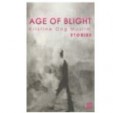“What if the end of man is not caused by some cataclysmic event, but by the nature of humans themselves?” This is the central question posed by Age of Blight, a dark yet captivating collection of speculative short stories by Kristine Ong Muslim. The stories’ answers to this question are as varied as they are troubling and, at times, they are disturbingly plausible.
The aspects of human nature explored in Age of Blight are the most malevolent ones, those with the potential to cause the greatest harm to the environment and to every creature inhabiting it. The categories into which the stories are grouped—“Animals,” “Children,” “Instead of Human,” and “The Age of Blight”—suggest the targets and consequences of that malevolence.
“The Wire Mother,” from the “Animals” section of the book, is told from the perspective of one of the inanimate “mothers” used in the experiments of Harry F. Harlow, a psychologist interested in the mother-child bond. In examining whether baby rhesus monkeys preferred bare-wire mothers or cloth-covered ones, Harlow found, among other things, that the baby monkeys visited the wire mothers only for bottle feedings; otherwise, they preferred the comforts of the cloth-covered mothers.
Yet in Muslim’s story, the wire mother, for all her “rows and columns of sharp teeth,” is shown to be quite compassionate, far more so than Harlow, whose experiments with isolating baby monkeys involved (I kid you not) the “Pit of Despair” and essentially amounted to torture. In one scene, the wire mother questions Harlow about his practices:
He said, “I’m sure it wasn’t very comfortable.”
Then I explained that he did not really have to torture the baby monkeys, that he could have just as easily predicted they won’t come out all right. All sentient creatures would not come out all right in those circumstances. It was a moot point.
“So why do you keep doing it?” I could not help but ask. And he said with the air of the unflappable, “Because I can.”
Though this type of indifference to (or even joy in) suffering may not lead to “the end of man” anytime soon, it may make such an ending feel deserved, at least from the perspective of those who bear the consequences of this indifference or cruelty. In “The Wire Mother,” Muslim presents this perspective vividly and with deep feeling.
While “The Wire Mother” features a real figure from the past, many of the later stories in Age of Blight examine alternative presents and possible futures, imagining various unsettling worlds that humans might create or have to confront. A few of the stories describe chilling transformations or creations that are in line with the most nightmarish possibilities of genetic engineering.
In one of my favorite stories from the collection, “Dominic & Dominic” (from the “Children” section), a six-year-old boy feels driven, for reasons he doesn’t understand, to bury his nail clippings in his backyard. Not long afterward, he finds fingers growing from the burial site, then a hand, then, eventually, a complete body double that no one but he can see. I won’t give away the ending, but I will say that in addition to delivering a blood-curdling chill, it raises troubling questions about identity, sense of self, and agency in a world in which humans might be engineered wholesale.
Another especially thought-provoking story is “Day of the Builders,” from “The Age of Blight” section of the book. It tells the all-too-familiar tale of one civilization—a village based in a previously unspoiled landscape—being colonized by another. In return for exploiting the villagers’ natural resources, the colonizers, a.k.a. the Builders, promise to erect, among other things, a hospital, a school, and factories that could “make more things faster.”
The villager who narrates the story realizes that this isn’t the good deal it’s purported to be, telling village elders that “once we let the Builders touch us, the dissolution of everything we believed in, everything we were, would begin.” The villager describes the elders discussing the matter “as though they still had a choice. I did not think we could make the Builders leave even if we wanted to.” He is right. The colonization moves forward unimpeded, making for a disturbing but inevitable-feeling ending in which the villager’s civilization becomes, literally, something for the history books.
It’s one more step toward the end of man, and it feels far more like truth than fiction.
Would My Pick be Your Pick?
If you're interested in ________, the answer may be "Yes":▪ Works of science fiction and/or horror
▪ Apocalyptic fiction
▪ Speculative or futuristic novels in the vein of the Oryx and Crake trilogy by Margaret Atwood and the Southern California trilogy by Kim Stanley Robinson






